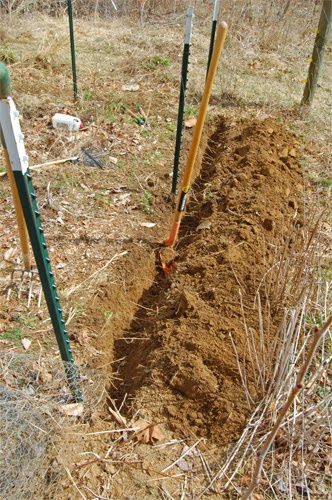Of course I had read that a good garden fence needs to go below the surface to keep out rabbits and groundhogs, I took the easy way out and only buried few inches of the chicken wire fence under the mulch. This was actually partially effective the first year, but last year there were several shallow entrances all around. One article I read, says to dig a trench 2 feet deep and a foot wide and line the bottom and side closest the fence line with chicken wire.That sounds pretty impressive. I got started, but hand digging a trench that size was beyond my limits of fun. I backed off a little and when with 12-16" deep and 6" wide.
Here's some photos of my project:
 |
| First, dig a trench. I used a narrow trenching shovel to make a narrow hole with pretty straight walls. This trench was only 14" deep and about 6" wide. |
 |
| Push in the chicken wire and bend it outwards at the bottom so that about 6" covers the bottom of the trench. This way if the critter tries to go deeper, it will be frustrated. |
 |
| Fill in the trench and compact the soil. Connect the buried chicken wire with the above ground fencing. I bent about 6" of the above ground portion outward to create another digging barrier. |
 |
| Cover the base of the above ground wire with soil and then mulch the area between the inner and outer fence. |
One of the features of my garden is a pollinator border consisting mostly of native plant species. Since many of these plants are vigorous seeders, I have an abundance of seedlings to move from the garden out to the border. Before I got started with trench digging I took a close look at the plants I would be digging up to determine with they were keepers or 'weeds'. Here are some photos of the ones I encountered:
 |
| This is an over-wintered rosette of Black-eyed Susan. It can be recognized, in part, by the soft fuzzy leaves |
At first glance the rosette of the weedy English plantain is similar to the Black-eyed Susan.
 |
| This English plantain has lance-shaped, deeply veined leaves |
 |
| This clump of common yarrow was dug out of the path of the new trench. |
 |
| These leaves did not break ground until the last week of March. |
Wild columbine, Aquilegia canadensis, is another short lived native perennial and is dependent on reseeding for its long term presence in the garden. The new leaves are a dark, purplish green and can be difficult to spot until they open up some. Before the leaves develop they could be mistaken for red clover.
 |
| There are a number of native Cardamine sp. around but they do not resemble this one |
There are many wild garlics, both native and introduced out in the garden. Since these have a tendency to deter small mammals, I have not been targeting them for removal. I planted nodding onion, Allium cernuum, in the garden border a year and a half ago. I have seen several resprouting, some are already about 6 inches tall.
 |
| The foliage of nodding onion is a flattened blade. The weedy field garlic, Allium vineale, found in many lawns has darker green tubular leaves |
 |
| Sheep sorrel spreads rapidly by shallow runners. |
The last weed I was tossing out was sheep sorrel, Rumex acetosella. The leaves of this plant can be used as a tart, lemony flavoring in soups and salads. The plant concentrates oxalic acid giving them a tart flavor; however, it can be toxic in high concentrations. I should probably consider trying it in a salad, in moderation.





